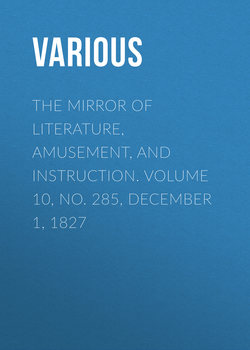Читать книгу The Mirror of Literature, Amusement, and Instruction. Volume 10, No. 285, December 1, 1827 - Various - Страница 4
CASTLE OF THE SEVEN TOWERS AT CONSTANTINOPLE
NAUTICAL PHRASES
Оглавление(To the Editor of the Mirror.)
Sir,—The annexed Definition of Nautical, Names, &c. will not, I dare say, to most of your readers, be uninteresting. G.W.N.
The Starboard is the right side of the ship, as the lar-board is the left.
The Parrel is a movable band-rope, used to fasten the yard to its respective mast.
Backstays are long ropes, reaching from the right and left sides of the vessel to the mast heads.
Travellers are slight iron rings, encircling the backstays, and are used for hoisting the top-gallant yards, and confining them to the backstays.
Rolling-tackle is a number of pulleys, engaged to confine the yard to the weather side of the mast; this tackle is much used in a rough sea.
Booms are masts or yards, lying on board in reserve.
The Courses are the mainsail, foresail, and the mizen.
The Staysail is of a triangular form, running upon the fore-topmast-stay, just above the bowsprit.
Reef-tackles are ropes employed in the operation of reefing. &c.
Clue-lines are used to truss up the clues, or to lower the corners of the largest sails.
The Brake is the handle of the pump, by which it is worked.
Bowlines are ropes for keeping the windward edge of the sail steady.
The Wells are places in the ship's hold for the pumps, &c.
Earings are small lines, by which the uppermost corners of the largest sails are secured to the yard-arms.
Reefs are spaces by which the principal sails are reduced when the wind is too high, and enlarged again when its force abates.
Topsails are long and square, of the second degree in magnitude in all great ships.
Haliards are single ropes, by which the sails are hoisted up and lowered at pleasure.
Tally is the operation of hauling aft the sheets, or drawing them in the direction of the ship's stern.
Towing is the operation of drawing a vessel forward by means of long lines, &c.
Timoneer, from the French timonnier, is a name given, on particular occasions, to the steersman of a ship.
Bars are large masses of sand or earth, formed by the surge of the sea; they are mostly found at the entrances of great rivers or havens, and often render navigation extremely dangerous.
The Ox-Eye, so called by seamen, is a remarkable appearance in the heavens, resembling a small lurid speck, and always precedes two particular storms, known only between the tropics.
Azimuth-Compass is an instrument employed for ascertaining the sun's magnetical azimuth.
Studding-Sails are long and narrow, and are used only in fine weather, on the outside of the large square sails.
Stay-Sails have three corners, and are hoisted up on the stays when the wind crosses the ship.
Broaching-to is a sudden movement in navigation, when the ship, while scudding before the wind, accidentally turns her side to windward.
Wales are a number of strong and thick planks, covering the lower part of the ship's side.
Scud is a name given by sailors to the lowest clouds; which are mostly observed in squally weather.
The Sheets are ropes used for extending the clues, or lowering the corners of the sails.
Brails are ropes used to truss up a sail to a mast or yard.
Reef-Bands are long pieces of rough canvass sewed across the sails to give them additional strength.
Scudding is a term applied to a vessel when carried furiously along by a tempest.
Leeward implies when the ship lies on that side to which the wind is directed.
Windbound means when the ship is detained in one particular station by contrary winds.
Windward is when the ship is in the direction of the wind.
